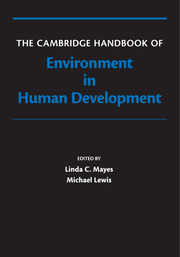Book contents
- The Cambridge Handbook of Environment in Human Development
- The Cambridge Handbook of Environment in Human Development
- Copyright page
- Contents
- Notes on Contributors
- The Role of Environments in Development:
- Part I The “Environmental” Variable
- Part II Contemporary Themes
- Part III Environments
- Part IV Measurement
- Index
The Role of Environments in Development:
An Introduction
Published online by Cambridge University Press: 05 October 2012
- The Cambridge Handbook of Environment in Human Development
- The Cambridge Handbook of Environment in Human Development
- Copyright page
- Contents
- Notes on Contributors
- The Role of Environments in Development:
- Part I The “Environmental” Variable
- Part II Contemporary Themes
- Part III Environments
- Part IV Measurement
- Index
Summary
- Type
- Chapter
- Information
- Publisher: Cambridge University PressPrint publication year: 2012
- 5
- Cited by



